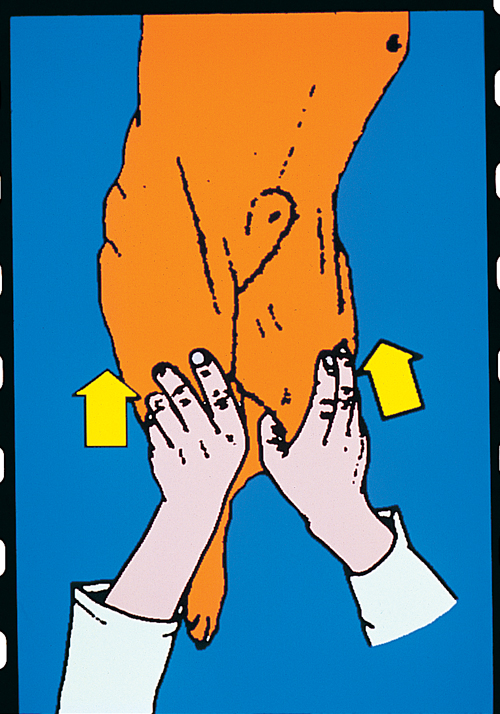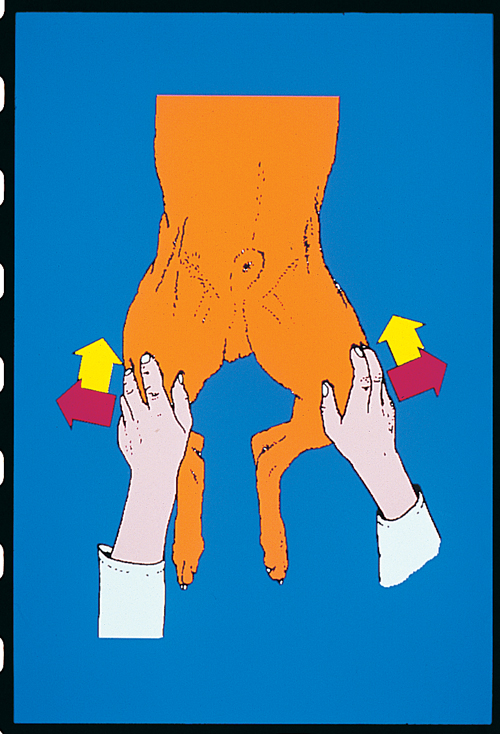Difference between revisions of "Small Animal Orthopaedics Q&A 08"
| Line 22: | Line 22: | ||
In severely affected dogs there is shortening of the swing phase in the contralateral forelimb at the trot in order to accommodate the shortened swing phase of the affected hind limb. | In severely affected dogs there is shortening of the swing phase in the contralateral forelimb at the trot in order to accommodate the shortened swing phase of the affected hind limb. | ||
| − | |l1= | + | |l1= |
|q2=What examination is being performed in the drawings? | |q2=What examination is being performed in the drawings? | ||
|a2= | |a2= | ||
| Line 34: | Line 34: | ||
The femurs are then abducted and the subluxated femoral head(s) will relocate into the acetabulum and the feeling is transmitted to the operator’s hands. Relocation of the femoral head in the acetabulum may also be detectable as an audible click. | The femurs are then abducted and the subluxated femoral head(s) will relocate into the acetabulum and the feeling is transmitted to the operator’s hands. Relocation of the femoral head in the acetabulum may also be detectable as an audible click. | ||
| − | |l2= | + | |l2= |
</FlashCard> | </FlashCard> | ||
Revision as of 22:18, 23 October 2011
| This question was provided by Manson Publishing as part of the OVAL Project. See more Small Animal Orthopaedics Q&A. |
These two drawings illustrate an examination used to evaluate young dogs suspected of having hip dysplasia.
| Question | Answer | Article | |
| What gait abnormalities are typically present in young dogs with hip dysplasia? | Affected dogs may have difficulty rising from a lying or sitting position. They may also exhibit lateral rotation of the pelvis by lateral bending of the lumbar spine, particularly towards the coxofemoral joint which is most painful. This minimizes the excursion of the femoral head in the acetabulum and therefore reduces the amount of pain generated in the coxofemoral joint. The dog’s head may be carried lower than normal, which causes a cantilever effect and reduces the amount of weight carried by the hips. If, at the trot, the lameness is unilateral, or more pronounced in one limb, the swing phase of that limb will be reduced and slower. The stance phase will also be shortened, as the dog attempts to minimize the amount of time that the affected (or more severely affected) coxofemoral joint is loaded. In severely affected dogs there is shortening of the swing phase in the contralateral forelimb at the trot in order to accommodate the shortened swing phase of the affected hind limb. |
[[|Link to Article]] | |
| What examination is being performed in the drawings? | The Ortolani examination. This examination is often performed with the dog under sedation. Although a positive Ortolani sign can be elicited in some dogs without sedation, a negative Ortolani examination can not be established unless a dog has been examined while heavily sedated or anesthetized. The dog is placed in dorsal recumbency and both femurs are positioned vertically, at right angles to the ground or table top. The stifles are flexed and axial pressure is exerted on the femurs. If laxity is present, the femoral head(s) will subluxate. The femurs are then abducted and the subluxated femoral head(s) will relocate into the acetabulum and the feeling is transmitted to the operator’s hands. Relocation of the femoral head in the acetabulum may also be detectable as an audible click. |
[[|Link to Article]] | |

